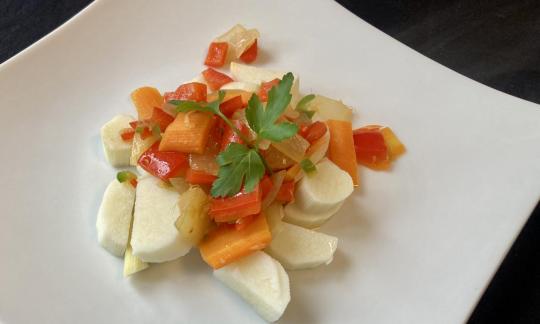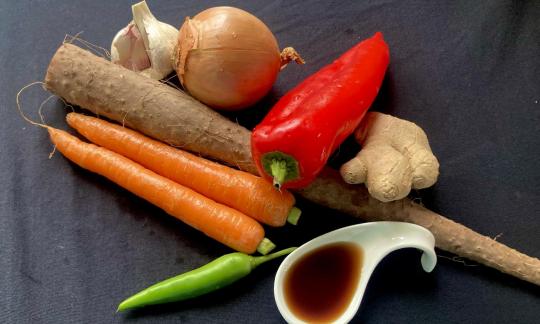Yam vegetables with pepper, carrot, chili and ginger
vegan
Ingredients (for servings, )
| For the yam vegetable | |
|---|---|
| 11 oz | Yams, raw (organic?) |
| 5 ½ oz | Carrots (carrots), raw (organic?) |
| 5 ½ oz | Pointed peppers (Hungarian, raw, organic?) |
| 1 large | Onions, raw (organic?) (5.3 oz) |
| 3 cloves | Garlic (organic?) (0.32 oz) |
| 1 ½ | Chili peppers, green (raw, organic?) (2.4 oz) |
| 2 cm | Ginger, raw (organic?) (0.76 oz) |
| For seasoning and refining | |
| 1 tbsp | Rapeseed oil, refined (organic?) (0.49 oz) |
| 1 tbsp | Reduced salt soy sauce (Genen-Shoyu, organic?, raw?) (0.56 oz) |
| 3 tbsp | Drinking water, raw (organic?) (0.61 oz) |
Equipment
- grater
- vegetable peeler
- skillet (frying pan)
- stove
- saucepan
Type of preparation
- cook
- chop or grind
- sweat
- season to taste
- remove the skin
- peel
- grate (shred)
Preparation
For the yam
Peel the yam, cut into bite-sized pieces and place in a suitable pot. Cover with water, add a little salt and simmer for about 15 minutes.In the meantime, proceed with the next steps.
For the remaining vegetables
Peel the carrots (you can also just clean organic carrots) and cut them lengthways into thin slices. Then quarter each one. Wash the peppers, remove the seeds and cut into bite-sized pieces. Peel the onions and garlic and dice finely. Finely dice the chili. Peel and grate the ginger.If you don't have pointed peppers, you can just as easily use regular peppers. We recommend red, slightly sweet peppers for this dish, but yellow or green ones are also suitable.
Completing the dish
Heat the rapeseed oil in a non-stick pan. Add the onions, carrots, peppers and chili and sauté. After about 3 minutes, add the garlic and ginger and stir. Add the soy sauce and possibly a few tablespoons of water and sauté for a few more minutes until the vegetables are cooked but still firm.
Mix in the yam from step 1. Season with soy sauce and chili and serve.The less soy sauce, the less salt and the healthier it is in the long term. Read more in the tips.
|
Nutritional Information per person
Convert per 100g
|
2000 kcal | |
|---|---|---|
| Energy | 359 kcal | 17.9% |
| Fat/Lipids | 8.0 g | 11.4% |
| Saturated Fats | 0.68 g | 3.4% |
| Carbohydrates (inc.dietary fiber) | 68 g | 25.2% |
| Sugars | 12 g | 13.7% |
| Fiber | 11 g | 44.4% |
| Protein/Albumin | 6.3 g | 12.5% |
| Cooking Salt (Na:326.8 mg) | 830 mg | 34.6% |
| Essential micronutrients with the highest proportions | per person | 2000 kcal | |
|---|---|---|---|
| Vit | Vitamin C (ascorbic acid) | 189 mg | 236.0% |
| Elem | Potassium, K | 1'902 mg | 95.0% |
| Vit | Vitamin A, as RAE | 707 µg | 88.0% |
| Vit | Vitamin B6 (pyridoxine) | 1.2 mg | 85.0% |
| Min | Manganese, Mn | 1.1 mg | 57.0% |
| Vit | Vitamin B9, B11 (Folate, as the active form of folic acid) | 112 µg | 56.0% |
| Min | Copper, Cu | 0.51 mg | 51.0% |
| Vit | Vitamin K | 34 µg | 45.0% |
| Sodium, Na | 327 mg | 41.0% | |
| Fat | Alpha-Linolenic acid; ALA; 18:3 omega-3 | 0.69 g | 34.0% |
Detailed Nutritional Information per Person for this Recipe
The majority of the nutritional information comes from the USDA (US Department of Agriculture). This means that the information for natural products is often incomplete or only given within broader categories, whereas in most cases products made from these have more complete information displayed.
If we take flaxseed, for example, the important essential amino acid ALA (omega-3) is only included in an overarching category whereas for flaxseed oil ALA is listed specifically. In time, we will be able to change this, but it will require a lot of work. An “i” appears behind ingredients that have been adjusted and an explanation appears when you hover over this symbol.
For Erb Muesli, the original calculations resulted in 48 % of the daily requirement of ALA — but with the correction, we see that the muesli actually covers >100 % of the necessary recommendation for the omega-3 fatty acid ALA. Our goal is to eventually be able to compare the nutritional value of our recipes with those that are used in conventional western lifestyles.
| Essential fatty acids | per person | 2000 kcal |
|---|---|---|
| Alpha-Linolenic acid; ALA; 18:3 omega-3 | 0.69 g | 34.0% |
| Linoleic acid; LA; 18:2 omega-6 | 1.7 g | 17.0% |
| Essential amino acids | per person | 2000 kcal |
|---|---|---|
| Threonine (Thr, T, irreversibly transaminated) | 0.30 g | 32.0% |
| Tryptophan (Trp, W) | 0.06 g | 23.0% |
| Isoleucine (Ile, I) | 0.20 g | 16.0% |
| Valin (Val, V) | 0.24 g | 15.0% |
| Leucine (Leu, L) | 0.33 g | 14.0% |
| Lysine (Lys, K, irreversibly transaminated) | 0.27 g | 14.0% |
| Phenylalanine (Phe, F) | 0.22 g | 14.0% |
| Methionine (Met, M) | 0.07 g | 7.0% |
| Vitamins | per person | 2000 kcal |
|---|---|---|
| Vitamin C (ascorbic acid) | 189 mg | 236.0% |
| Vitamin A, as RAE | 707 µg | 88.0% |
| Vitamin B6 (pyridoxine) | 1.2 mg | 85.0% |
| Vitamin B9, B11 (Folate, as the active form of folic acid) | 112 µg | 56.0% |
| Vitamin K | 34 µg | 45.0% |
| Vitamin E, as a-TEs | 4.0 mg | 33.0% |
| Vitamin B1 (Thiamine) | 0.35 mg | 32.0% |
| Vitamin B3 (Niacin) | 2.9 mg | 18.0% |
| Vitamin B5 (Pantothenic acid) | 0.99 mg | 17.0% |
| Vitamin B2 (Riboflavin) | 0.19 mg | 14.0% |
| Vitamin B7 (Biotin, ex vitamin H) | 6.8 µg | 14.0% |
| Essential macroelements (macronutrients) | per person | 2000 kcal |
|---|---|---|
| Potassium, K | 1'902 mg | 95.0% |
| Sodium, Na | 327 mg | 41.0% |
| Phosphorus, P | 178 mg | 25.0% |
| Magnesium, Mg | 74 mg | 20.0% |
| Calcium, Ca | 93 mg | 12.0% |
| Essential trace elements (micronutrients) | per person | 2000 kcal |
|---|---|---|
| Manganese, Mn | 1.1 mg | 57.0% |
| Copper, Cu | 0.51 mg | 51.0% |
| Iron, Fe | 2.1 mg | 15.0% |
| Zinc, Zn | 1.1 mg | 11.0% |
| Selenium, Se | 2.6 µg | 5.0% |
| Iod, I (Jod, J) | 4.3 µg | 3.0% |
| Fluorine, F | 12 µg | < 0.1% |
The vitamin-rich yam vegetable with pepper, carrot, chili and ginger is easy to make.
Nutrient profile: According to GDA guidelines, one portion of this dish covers several times the average daily requirement of vitamin C and 100% of that of vitamin A and potassium. However, some of the heat-sensitive ingredients are lost during the cooking process, which slightly reduces the amount per portion. The ratio of omega-6 to omega-3 fatty acids is 3:1, which is well below the maximum recommended ratio of 5:1. You can find more information on the subject at the following link: Vegans often eat unhealthily. Avoidable nutritional errors.
Yam: The yam, which is widespread in Africa, Asia and South America, is only edible cooked except for two types, as it is toxic when eaten raw. The Chinese yam, on the other hand, can be eaten raw. Yams are prepared in a similar way to potatoes - they can be boiled, baked or fried. Their taste is similar to that of sweet potatoes, but tastes much less sweet. The consistency is also similar to that of sweet potatoes or potatoes. Yams are rich in provitamin A.
Ginger: The ginger rhizome has an aromatic smell, the taste is sharp, spicy, which is due to the substance gingerol, which is said to have anti-carcinogenic and anti-inflammatory effects.
Buy yams: Yams are not very common as a food in Germany, so it is not easy to find good roots. You can usually find them in Asian markets, less often in organic shops.
Reduce salt and oil: We have deliberately reduced the amount of salt and oil for health reasons. Season to your liking with low-salt soy sauce or a little salt. However, try to keep the salt content as low as possible. You can find more information on this topic in the book we describe in detail: "Salt Sugar Fat" by Michael Moss.
Cold-pressed rapeseed oil is not suitable for sautéing vegetables, as cold-pressed oils can only be heated slightly, in the case of cold-pressed rapeseed oil up to a maximum of 120 °C, as otherwise harmful substances are created. See the following link ( cold-pressed rapeseed oil). But refined rapeseed oil should also be heated up to a maximum of 180 °C. Under no circumstances should it start to smoke, although decomposition will begin before that.
Because of the high carbohydrate content of the yam, you can eat the vegetable without any side dish. Alternatively, you can serve it with wholegrain rice or quinoa.






